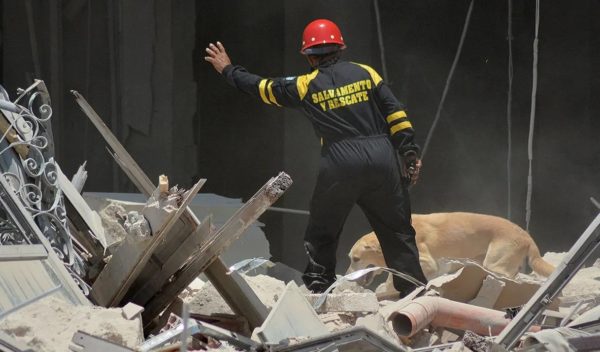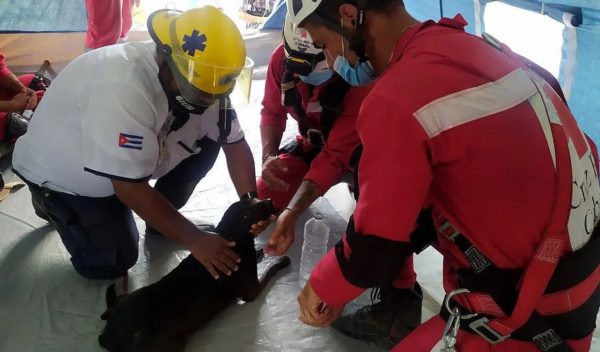Canine Survivors and Heroes Amid the Saratoga Hotel Tragedy

By Laura Seco Pacheco (El Toque)
HAVANA TIMES – Chuza found a home. She was one of the two dogs rescued from amongst the rubble created by the Hotel Saratoga explosion in Havana. After staying at a temporary home for several days, she was given to her owner’s relatives on May 11th, according to the animal rights group “Pasos”. Her owner had lost her life during the disaster.
After the explosion at the Saratoga, firefighters and rescue workers’ first job was to find survivors, but not only human ones. Every life counts.
Two days after the accident (May 8th), rescue teams found two dogs alive amid the rubble of a neighboring building, which was also damaged by the Hotel’s collapse. According to Cubadebate, a female dog (Chuza) and a male dog (Sultan) were rescued minutes apart.
Sultan is also with relatives of his owner, who lost his life in the accident.
Arnaldo Alvarez, member of the Cuban Red Cross, explained to Cubadebate that first aid was administered to both animals immediately, and that despite their shock, they hadn’t sustained any physical injuries. They also notified some animal rights groups to take care of them.
A few minutes later, a volunteer from the “Pasos” group collected them both and took them to the veterinary clinic on 18th Street, in Vedado. The group’s Facebook page announced that Sultan was recovering, although he was still a little “shocked” by the scare. Meanwhile, Chuza had suffered a blow to her back left leg, but it was only a muscular injury; and she’d recover with rest and painkillers.
The family of Sultan’s owner, Maria Consuelo Alvarez Valdez (who was missing at the time), took him in on May 8th. The elderly 77-year-old woman was living in Apartment 201 of the building next to the hotel. Her lifeless body was discovered on Tuesday May 10th.
Chuza had been transfered to a shelter because relatives of her owner, Juan Carlos Diaz Alvarez, didn’t feel they were in a position to take her in. Fifty-five-year-old Juan Carlos’ body was also discovered on May 10th.

FOUR-PAWED HEROES
A few minutes after search and rescue efforts began amongst the rubble of the Hotel Saratoga, rescue dogs arrived on the scene of the accident.
Dianko, Tito, Xila, Yomy and Rocky are the names of the five labradors that belong to the dog unit of the Ministry of Interior’s Special Brigade, who worked to locate missing victims under tons of rubble.
A bark from one of these dogs amidst the disaster becomes a breath of fresh hope. They are the first ones to go into the ruins and track down bodies. Then, heavy machinery is used to move the rubble.
Photos of the labradors working on the scene of the accident or resting in the nearby park went viral on social media. People soon reacted and many people became aware of the work of these hairy heroes.
“If you think rescuing dogs is a waste of time, dogs are rescuing people right now,” Pasos wrote on Twitter.
On this same social media network, user Ivon Otero published a photo of firefighters with rescue dogs and wrote: “This is for those who criticize animal activism, they do this and so much more for us without expecting anything in return.”
These dogs’ sense of smell is key to finding bodies under the rubble. They worked day and night to find missing people after the collapse.
“Rescue workers check the area, and if they have any doubts or information from a neighbor or relative about the possible location of a missing person, and they don’t find them, then we go in, because searching with dogs is a lot more effective. There is no technology or any other kind of substitute for their work and its time-result relationship,” Aliesky Mota, a member of the 15th Command of the Special Rescue Detachment and owner of Dianko, told Cubadebate.
Dianko was one of the first dogs to enter the building and he injured his paw slightly during the rescue operation. As soon as he recovered, he went to the track the trail of missing people.
Rocky, another labrador, took part in an international mission in Ecuador after the earthquake in this country, in April 2016.
Rescue dogs are known as binomials, because of the symbolic and emotional relationship they have with their human companions, who train and work with them for years to develop their tracking skills.





